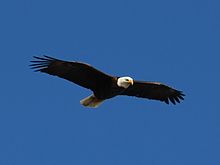Environmental: Difference between revisions
Rmanwaring (talk | contribs) No edit summary |
No edit summary |
||
| (4 intermediate revisions by 3 users not shown) | |||
| Line 2: | Line 2: | ||
[[Category:Home]] | [[Category:Home]] | ||
---- | ---- | ||
{{Picture | {{Picture | ||
|image= | |image= | ||
| Line 10: | Line 9: | ||
<!--https://en.wikipedia.org/wiki/Bald_eagle--> | <!--https://en.wikipedia.org/wiki/Bald_eagle--> | ||
|caption= | |caption= | ||
Bald eagles, a migratory bird, have been known to establish nests near dams ([https://en.wikipedia.org/wiki/Bald_eagle Wikipedia]) | Bald eagles, a migratory bird, have been known to establish nests near dams. | ||
(Image Source: [https://en.wikipedia.org/wiki/Bald_eagle Wikipedia]) | |||
}} | }} | ||
< | "Environmental is defined as the ability to best achieve stewardship of air, water, land, animals, plants, and other natural resources when constructing and operating the project, and complying with the Environmental Impact Statement or Assessment or other environmental related project requirements. Sustainability is defined as using methods, systems, and materials that optimize incorporation of a site’s natural land, water, and energy resources as integral aspects of the development and minimize or avoid harm to the air, water, land, energy, human ecology and nonrenewable resources on- and off-site of the project." <ref name="ER415111">[[Engineering and Construction: Biddability, Constructability, Operability, Environmental and Sustainability Reviews (ER 415-1-11) | Engineering and Construction: Biddability, Constructability, Operability, Environmental and Sustainability Reviews (ER 415-1-11), 2013]]</ref> | ||
* [[Baseline Natural & Cultural Resources]] | In order to protect the [[environment]] and encourage sustainability, many local, state and federal entities require dam owners to obtain permits to construct, maintain and operate, or modify a dam. Typical [[permitting]] activities include: | ||
* [[Required Permit Identification]] | * [[Baseline Natural & Cultural Resources Review]] | ||
* [[Permitting|Required Permit Identification]] | |||
* [[Permit Application and Approval Process]] | * [[Permit Application and Approval Process]] | ||
Latest revision as of 17:43, 28 July 2023

|
| Bald eagles, a migratory bird, have been known to establish nests near dams.
(Image Source: Wikipedia) |
"Environmental is defined as the ability to best achieve stewardship of air, water, land, animals, plants, and other natural resources when constructing and operating the project, and complying with the Environmental Impact Statement or Assessment or other environmental related project requirements. Sustainability is defined as using methods, systems, and materials that optimize incorporation of a site’s natural land, water, and energy resources as integral aspects of the development and minimize or avoid harm to the air, water, land, energy, human ecology and nonrenewable resources on- and off-site of the project." [1]
In order to protect the environment and encourage sustainability, many local, state and federal entities require dam owners to obtain permits to construct, maintain and operate, or modify a dam. Typical permitting activities include:
- Baseline Natural & Cultural Resources Review
- Required Permit Identification
- Permit Application and Approval Process
Types of Environmental Impacts
- Hazard Potential
- Wetlands and Waterways
- Protected Species
- Floodplain
- Cultural Resources
- Contamination / Environmental Pollutants
- Aquatic Life Movement
- Permanent Impacts vs. Temporary Impacts
- Wildlife Habitats / Unique Habitats
- Recreational Use Impacts
- Drinking Water Supply
Revision ID: 7473
Revision Date: 07/28/2023
